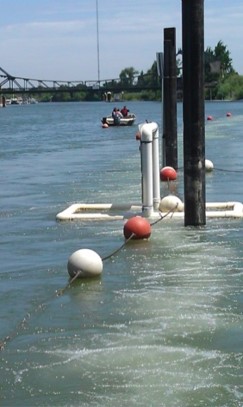Georgiana Slough Salmonid Migratory Barrier Project
Under the National Marine Fisheries Service (NMFS) 2009 Biological Opinion and Conference Opinion on the Long-Term Operations Of The Central Valley Project and State Water Project (BiOp) Reasonable and Prudent Alternative (RPA) Action IV.1.3 (Action) the Department of Water Resources (DWR) and U.S. Bureau of Reclamation (USBR) are required to consider engineering solutions to further reduce the diversion of emigrating juvenile salmonids to the interior and southern Delta and reduce exposure to Central Valley Project (CVP) and State Water Project (SWP) export facilities. DWR’s Water Projects Planning and Management Branch has led the RPA compliance work and is working towards the implementation of engineering solutions intended to benefit salmon populations and maintain CVP and SWP water supply reliability. The Action has been organized into a multi-year study consisting of three phases:
Phase I – Initial Findings (2011-2013)
During Phase I, a Technical Working Group (TWG) was established. This TWG reviewed possible locations to reduce the diversion of salmonids and proposed possible engineering solutions for consideration.
Phase II – Recommended Solutions (2012-2015)
Phase II conducted detailed evaluations of options considered during Phase I, conducted field studies, prepared conceptual barrier design details, and based on existing information, developed recommended engineering solutions for each of the five study locations:
- Georgiana Slough (Sacramento River)
- Three-mile Slough (Sacramento River)
- Head of Old River (San Joaquin River)
- Turner Cut (San Joaquin River)
- Columbia Cut (San Joaquin River)
DWR performed field studies at Georgiana Slough (2011 and 2012) and at the Head of Old River (2009 and 2010) to assess the effectiveness of a non-physical barrier design (Bio-Acoustic Fish Fence, or BAFF). In 2014, the effectiveness of a physical barrier design (Floating Fish Guidance Structure, or FFGS) was studied at Georgiana Slough.
Implementation of Preferred Option (2020-2030)
In 2020, the California Department of Fish and Wildlife (CDFW) issued their SWP Incidental Take Permit (ITP) which directs DWR to annually construct and operate a seasonal salmon migratory barrier at Georgiana Slough by March 31, 2023. To fulfill this requirement, DWR has developed and will implement the Georgiana Slough Salmonid Migratory Barrier (GSSMB) Project beginning in early 2023.
The GSSMB Project includes the seasonal installation of a BAFF in a similar location to the 2011 and 2012 field studies though with a slightly modified alignment. Additionally, installation and operation of the BAFF is currently planned for eight years starting in late 2023 through 2030 in response to the 2020 CDFW SWP ITP. In each year of operation, DWR will conduct monitoring to assess the performance of the BAFF. This may include the deployment of fish tracking and other data collection monitoring equipment, including installation of steel piles to attach equipment for hydroacoustic and hydrodynamic barrier operational monitoring.
The first year of BAFF installation will be considered the Commissioning Phase. This will be followed by annual operations through 2030.
Tentative 2023 Schedule
- March 2023 – Secure Permit Applications
- September 2023 – Commence pile driving and BAFF installation
- November 2023 – Commence BAFF operations
- May 2024 – Complete BAFF operations
- June 2024 – Complete removal of BAFF frames
Contact Information
Requests for information about this project may be directed to:
Shahid Anwar
Senior Water Resources Engineer
Division of Operations and Maintenance
Water Projects Planning and Management Branch
California Department of Water Resources
1516 Ninth Street
Sacramento, CA 95814
Email: Mohammed.Anwar@water.ca.gov
Telephone: (916) 288-2129

2011-2012 Bio-Acoustic Fish Fence in operation
